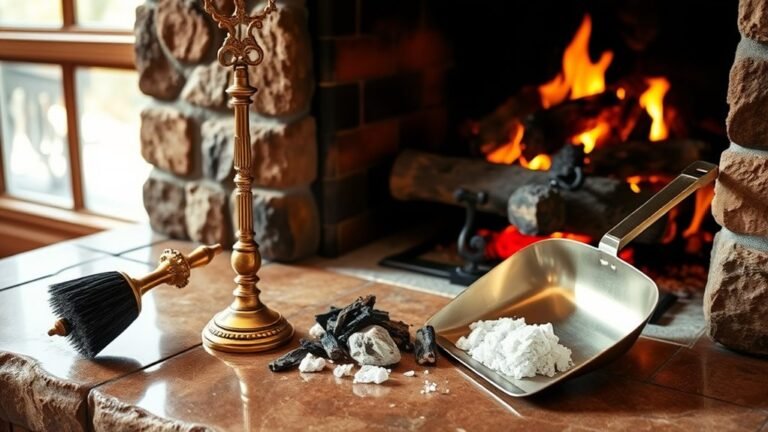Best Products to Clean Your Laundry
To clean your laundry effectively, choose detergents with targeted enzymes and proper concentration for different fabrics and stain types. Use liquid detergents for delicate or cold water washes, powders for heavy soils, and gentle formulas without enzymes for silks or wools. For tough stains, enzymatic or oxygen-based removers work best. Eco-friendly, biodegradable options minimize environmental impact. If you have a high-efficiency machine, use HE-labeled products to avoid residue. Keep going to discover specialized products and fabric care tips.
Top Laundry Detergents for Everyday Use

Choosing the right laundry detergent is essential for maintaining fabric quality and ensuring effective stain removal. When selecting between liquid detergents and powder detergents, consider your washing machine type and water hardness. Liquid detergents dissolve quickly, offering superior performance in cold water and on delicate fabrics. Powder detergents are often more cost-effective and excel in removing ground-in dirt, particularly in hot water. You should also evaluate detergent concentration and enzyme content, which directly impact cleaning power and fabric care. For everyday use, opt for formulations free from unnecessary fillers to maintain fabric integrity and reduce residue buildup. By understanding these technical distinctions, you gain the freedom to tailor your laundry routine precisely, balancing cleaning efficiency with fabric longevity.
Effective Stain Removers for Tough Spots
When tackling tough stains, you’ll want to choose between enzymatic, oxygen-based, or solvent stain removers based on the spot’s composition. Applying the remover promptly and following product-specific instructions guarantees maximum effectiveness without damaging fabric fibers. Understanding these types and application techniques helps you treat stains precisely and efficiently.
Types of Stain Removers
How do you tackle the toughest stains that standard detergents can’t remove? You need specialized stain removers designed for precision. Enzyme-based removers are highly effective against protein-based stains like blood, sweat, and food. These enzymes break down complex molecules into smaller, washable components—freeing your fabric without harsh chemicals. Alternatively, natural stain solutions use plant-derived ingredients such as lemon juice, baking soda, or vinegar, offering eco-friendly options without sacrificing power. Oxygen-based bleaches target organic stains by releasing oxygen radicals that dismantle color-causing compounds, while solvent-based removers excel on grease and oil by dissolving hydrophobic residues. Understanding these types lets you select the right remover for your stain, ensuring freedom from lingering marks and fabric damage. Choose the remover that matches your stain’s chemistry for ideal results.
Application Tips for Stains
Although selecting the right stain remover is essential, applying it correctly can make all the difference in tackling tough spots effectively. Start by pre treating stains immediately to prevent them from setting; use a targeted stain remover and gently blot the area rather than rubbing, which can spread the stain or damage fabric fibers. Employ stain removal techniques like applying the product directly to the stain’s back side to push it out of the fabric. Allow the remover to penetrate for the recommended time—usually 5 to 10 minutes—before laundering. For stubborn stains, repeat pre treating and use warm water if the fabric allows. Remember, precise application and timing maximize the remover’s efficacy, giving you the freedom to wear your favorite clothes without worry.
Gentle Cleaners for Delicate Fabrics

Because delicate fabrics require special care, you’ll want to choose cleaners formulated to protect fibers while effectively removing dirt and oils. Opt for gentle detergents with pH-neutral formulas and biodegradable surfactants that minimize fiber damage. These cleaners often support hand wash protocols, allowing you to maintain fabric integrity without harsh agitation. Look for products free from enzymes and optical brighteners, as these can degrade sensitive materials. When using gentle cleaners, dilute properly and avoid excessive soaking to preserve fabric elasticity and colorfastness. Prioritize products labeled for silk, wool, or lace, as they provide specialized fabric care. By selecting the right gentle cleaner, you gain freedom to confidently care for your delicate wardrobe, extending garment life while maintaining softness and appearance.
Eco-Friendly Laundry Products
Eco-friendly laundry products combine biodegradable ingredients, reduced chemical content, and sustainable packaging to minimize environmental impact without compromising cleaning efficiency. When you choose biodegradable detergents, you reduce water pollution and protect aquatic ecosystems. Sustainable packaging further cuts waste and supports a circular economy. Here’s a technical overview to help you make informed decisions:
| Product Type | Key Feature | Environmental Benefit |
|---|---|---|
| Biodegradable Detergents | Enzymatic formula | Rapid decomposition in water |
| Concentrated Liquids | Reduced packaging volume | Less plastic use |
| Powdered Detergents | No phosphates | Prevents eutrophication |
| Refillable Packs | Sustainable packaging | Minimizes landfill waste |
Selecting these products gives you freedom to care for your clothes and planet simultaneously.
Fabric Softeners and Fresheners

Beyond cleaning, maintaining the texture and scent of your fabrics plays a significant role in laundry care. Fabric softeners condition fibers, reducing static and enhancing softness, which prolongs garment life and comfort. When using fabric softeners, measure precisely to avoid residue buildup that can impair absorbency. Scent boosters are an excellent addition, releasing fragrance gradually to keep your laundry smelling new for days. These boosters often contain microcapsules that adhere to fabric fibers, ensuring long-lasting scent without overpowering. Fabric sprays provide an on-demand solution for revitalizing clothes between washes. Opt for sprays with mild, non-staining formulas to maintain fabric integrity. Integrating these products thoughtfully lets you tailor your laundry’s feel and aroma, freeing you from the constraints of just basic cleanliness.
Specialty Products for High-Efficiency Machines
When you’re using a high-efficiency (HE) washing machine, it’s crucial to choose detergents specifically formulated for these models to guarantee peak performance. High efficiency detergents are low-sudsing and designed to work with less water, preventing residue buildup and ensuring effective cleaning. Proper machine maintenance also depends on using these specialty products to avoid clogs and preserve your washer’s lifespan.
| Product Type | Key Benefit |
|---|---|
| HE Liquid Detergent | Fast dissolving, low suds |
| HE Powder Detergent | Long shelf life, powerful stain removal |
| HE Machine Cleaner | Removes residue, prolongs life |
Selecting the right HE detergents supports your freedom to wash efficiently without compromising your machine’s function or your laundry’s cleanliness.
Frequently Asked Questions
How Often Should I Clean My Washing Machine?
You should perform washing machine maintenance about once a month to keep it in top shape. This cleaning frequency helps prevent mold, detergent buildup, and unpleasant odors. Focus on running a hot water cycle with a cleaning agent or vinegar, wiping seals, and leaving the door open to dry. Regular upkeep guarantees your machine runs efficiently, saving you time and hassle while maintaining your freedom from unexpected breakdowns or costly repairs.
Can I Use Laundry Detergent for Handwashing Clothes?
Imagine handwashing clothes like a Victorian laundress with a modern twist. Yes, you can use laundry detergent for handwashing, but choose a mild, gentle formula to avoid fabric damage. For effective handwashing tips, dissolve detergent fully in water before soaking clothes to prevent residue. Alternatively, consider detergent alternatives like soap nuts or castile soap for a more natural approach. Always rinse thoroughly to maintain fabric integrity and freedom from harsh chemicals.
What Is the Best Water Temperature for Washing Different Fabrics?
You’ll want to match water temperature to fabric type for best results. Use cold water for delicate fabrics like silk or wool to prevent shrinking and color bleeding. Hot water’s great for whites and heavily soiled cottons since it kills bacteria and removes grime effectively. Medium or warm water’s a good compromise for everyday items, balancing cleaning power and fabric care. Adjust temps freely based on your fabric’s needs to keep clothes lasting longer.
How Do I Remove Odors From Workout Clothes?
When your workout fabric carries a bit of a stubborn bouquet, you’re not alone. To gently erase those lingering scents, start by pre-soaking in a solution with odor neutralizers designed for synthetic fibers. Use cold water to protect the fabric’s integrity, then wash with a detergent formulated for activewear. Avoid fabric softeners—they trap smells. Finish by air drying in fresh air; this natural step helps maintain freedom from unwanted odors while preserving your gear’s performance.
Are Laundry Pods Safe for Children and Pets?
Laundry pods can be hazardous if accessed by children or pets due to their concentrated chemicals. For laundry safety, always store pods in locked cabinets or high places beyond reach. Pet precautions include ensuring pods aren’t left out after use, as ingestion can cause severe health issues. If you want freedom in your home, establishing strict storage habits prevents accidents and keeps everyone safe while still enjoying the convenience pods offer for cleaning laundry.






